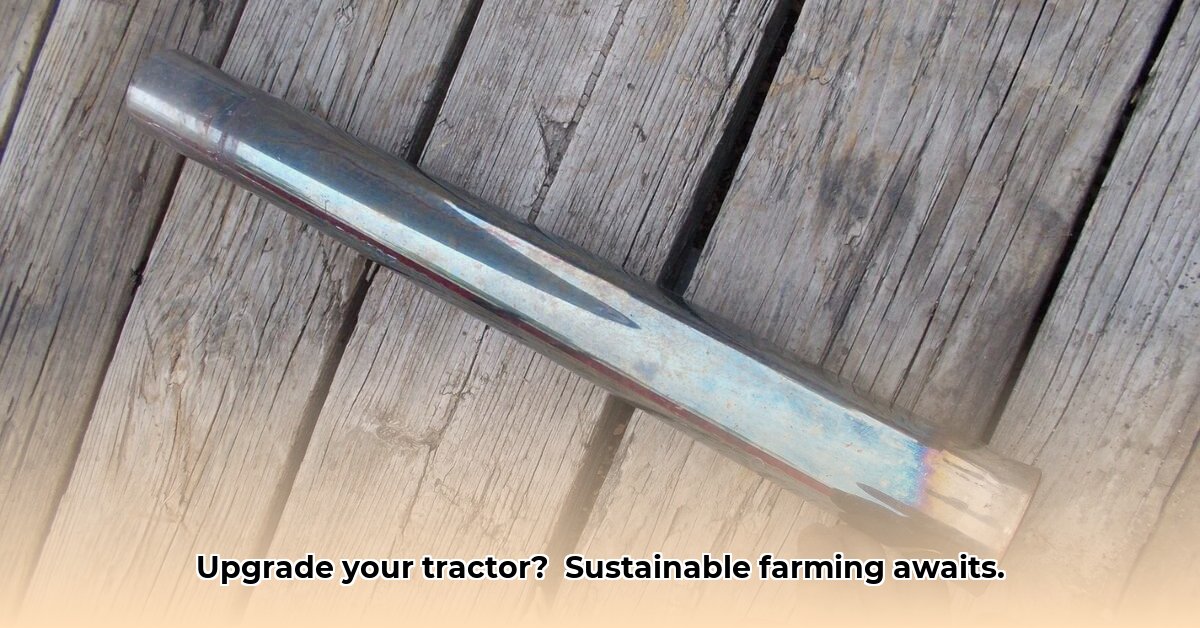
Exhaust Pipe for Tractor: Sustainable Upgrades for Your Farm
Let's discuss the often-overlooked impact of tractor exhaust systems on sustainable agriculture. Older tractors, while reliable, significantly contribute to greenhouse gas emissions. Upgrading your exhaust system isn't merely about regulatory compliance; it's a crucial step towards environmentally responsible farming and long-term economic viability.
Understanding Your Tractor's Exhaust: More Than Just a Pipe
Your tractor's exhaust system is more than just a pipe; it's a vital component of the engine, expelling combustion byproducts. A poorly functioning system restricts airflow, leading to reduced engine efficiency and increased harmful emissions. Regular inspection is vital; look for cracks, rust, or blockages that impede airflow. Think of it like a clogged artery—it restricts the smooth flow necessary for optimal performance.
The "Why" Behind an Exhaust Upgrade: Benefits Beyond Compliance
The advantages of upgrading your tractor's exhaust system extend far beyond meeting regulations.
Environmental Stewardship: Older tractors release substantial pollutants into the atmosphere and water systems. Modern exhaust upgrades dramatically reduce these emissions, fostering cleaner air and water—essential for human health and the long-term health of the land. Are you ready to contribute to a healthier environment?
Engine Efficiency and Fuel Savings: A well-functioning exhaust system facilitates smoother, more efficient combustion. This translates to better fuel economy, reducing operating costs. Improved fuel efficiency also minimizes engine wear and tear, extending its lifespan. How much could you save on fuel costs annually?
Extended Tractor Lifespan: Investing in a durable exhaust system protects your engine from back pressure and corrosion-related damage, thus extending its operational life and reducing the need for expensive repairs. What's the long-term return on investment for a sustainable upgrade?
Regulatory Compliance: Agricultural emission regulations are becoming increasingly stringent globally. Upgrading ensures compliance, avoiding potential penalties or operational restrictions. Are you prepared for upcoming regulations?
Choosing the Right Replacement: A Careful Consideration
Selecting the appropriate replacement exhaust pipe requires careful consideration:
Tractor Model Compatibility: The replacement must precisely match your tractor model. Consult your owner's manual or your equipment dealer for the correct specifications. Using an incompatible part can severely damage your engine.
Material Matters: Stainless steel offers superior durability and corrosion resistance. While pricier upfront, its longevity translates to long-term cost savings. Aluminized steel provides a more budget-friendly option, but its lifespan is typically shorter.
Diameter and Fit: Incorrect diameter significantly impacts engine performance. Measure your existing pipe carefully to ensure a perfect fit. A mismatched pipe leads to leaks, causing performance issues and increased emissions.
Budgetary Constraints: Balance upfront costs with long-term benefits. While stainless steel offers greater longevity, assess your budget and choose the option that best suits your needs.
Upgrading Your Tractor Exhaust: A Step-by-Step Guide
Upgrading your exhaust system is manageable, but safety is paramount.
Step 1: Thorough Research: Identify a compatible replacement exhaust pipe. Consult your owner’s manual or your equipment supplier.
Step 2: Preparation: Gather necessary tools (basic hand tools are often sufficient) and wear appropriate protective gear (gloves, eye protection, respirator). Prioritize safety.
Step 3: Careful Removal: Carefully remove the old pipe, taking photos to aid reassembly. Label components for easier reinstallation.
Step 4: Precise Installation: Install the new pipe precisely, ensuring correct alignment and secure fastening. Check connections for leaks using soapy water.
Step 5: Post-Installation Testing: Run the engine briefly and inspect the new pipe for leaks or issues.
Weighing the Pros and Cons: A Realistic Assessment
Upgrading your tractor's exhaust presents environmental and economic advantages, but consider both sides:
| Feature | Advantages | Potential Drawbacks |
|---|---|---|
| Environmental Impact | Significantly reduced greenhouse gas emissions, cleaner air and water | Initial investment cost |
| Engine Performance | Improved fuel efficiency and potentially increased horsepower, reduced wear and tear | Minimal performance gains on modern, already efficient tractors |
| Longevity | Extended lifespan of your tractor and reduced long-term maintenance expenses | Ongoing maintenance might still be needed (e.g., cleaning) |
| Compliance | Guaranteed compliance with increasingly stricter emission regulations | Costs can vary significantly depending on the tractor and parts |
If unsure, consult a qualified mechanic. A well-maintained exhaust system is a worthwhile investment.
How to Reduce Tractor Exhaust Emissions for Small-Scale Farmers
Key Takeaways:
- Upgrading your exhaust system significantly reduces emissions.
- Regular maintenance is crucial for optimal engine performance and emission reduction.
- Exploring alternative fuels and farming practices further minimizes environmental impact.
- Understanding the cost-benefit trade-offs is essential for small-scale farmers.
Understanding the Problem: Why Reduce Emissions?
Even smaller tractors contribute to air pollution through emissions of nitrogen oxides and particulate matter. These pollutants negatively impact air and water quality, harming human health and the environment. Emission reduction is vital for a healthier and more sustainable farming future.
Simple Steps for Emission Reduction
1. Regular Maintenance: Clean air filters regularly, ensure proper engine tune-ups, and inspect the exhaust system for leaks or blockages.
2. Fuel Efficiency: Maintain proper tire inflation, avoid idling, and practice smooth operation to reduce fuel consumption and emissions.
3. Advanced Technologies (Budget Permitting): Consider exhaust aftertreatment systems (particulate filters and SCR) or alternative fuels (biofuels), though these can be costly.
Practical Considerations for Small-Scale Farmers
Conduct a thorough cost-benefit analysis before implementing emission-reducing measures. Prioritize simple, affordable changes before considering major upgrades. Check technology compatibility and explore local resources and support programs.
The Long-Term Vision: Sustainable Farming Practices
Reducing tractor exhaust emissions is part of a broader sustainability strategy. Incorporate crop rotation, conservation tillage, and responsible fertilizer management for a holistic approach.